ESP Seat Ateca 2016 Owners Manual
[x] Cancel search | Manufacturer: SEAT, Model Year: 2016, Model line: Ateca, Model: Seat Ateca 2016Pages: 328, PDF Size: 6.32 MB
Page 277 of 328
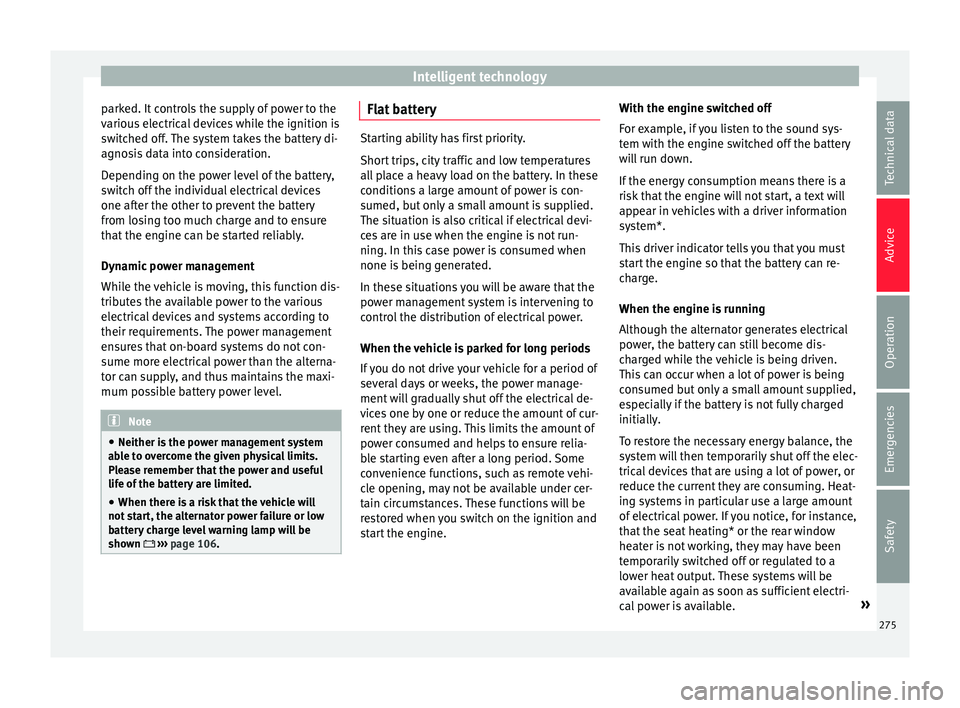
Intelligent technology
parked. It controls the supply of power to the
v ariou
s electrical devices while the ignition is
switched off. The system takes the battery di-
agnosis data into consideration.
Depending on the power level of the battery,
switch off the individual electrical devices
one after the other to prevent the battery
from losing too much charge and to ensure
that the engine can be started reliably.
Dynamic power management
While the vehicle is moving, this function dis-
tributes the available power to the various
electrical devices and systems according to
their requirements. The power management
ensures that on-board systems do not con-
sume more electrical power than the alterna-
tor can supply, and thus maintains the maxi-
mum possible battery power level. Note
● Neither i s
the power management system
able to overcome the given physical limits.
Please remember that the power and useful
life of the battery are limited.
● When there is a risk that the vehicle will
not s
tart, the alternator power failure or low
battery charge level warning lamp will be
shown ››› page 106. Flat battery
Starting ability has first priority.
Shor
t
trips, city traffic and low temperatures
all place a heavy load on the battery. In these
conditions a large amount of power is con-
sumed, but only a small amount is supplied.
The situation is also critical if electrical devi-
ces are in use when the engine is not run-
ning. In this case power is consumed when
none is being generated.
In these situations you will be aware that the
power management system is intervening to
control the distribution of electrical power.
When the vehicle is parked for long periods
If you do not drive your vehicle for a period of
several days or weeks, the power manage-
ment will gradually shut off the electrical de-
vices one by one or reduce the amount of cur-
rent they are using. This limits the amount of
power consumed and helps to ensure relia-
ble starting even after a long period. Some
convenience functions, such as remote vehi-
cle opening, may not be available under cer-
tain circumstances. These functions will be
restored when you switch on the ignition and
start the engine. With the engine switched off
F
or e
xample, if you listen to the sound sys-
tem with the engine switched off the battery
will run down.
If the energy consumption means there is a
risk that the engine will not start, a text will
appear in vehicles with a driver information
system*.
This driver indicator tells you that you must
start the engine so that the battery can re-
charge.
When the engine is running
Although the alternator generates electrical
power, the battery can still become dis-
charged while the vehicle is being driven.
This can occur when a lot of power is being
consumed but only a small amount supplied,
especially if the battery is not fully charged
initially.
To restore the necessary energy balance, the
system will then temporarily shut off the elec-
trical devices that are using a lot of power, or
reduce the current they are consuming. Heat-
ing systems in particular use a large amount
of electrical power. If you notice, for instance,
that the seat heating* or the rear window
heater is not working, they may have been
temporarily switched off or regulated to a
lower heat output. These systems will be
available again as soon as sufficient electri-
cal power is available. »
275
Technical data
Advice
Operation
Emergencies
Safety
Page 281 of 328

Checking and refilling levels
CAUTION
● The v
ehicle is not designed for the use of
FAME fuel (biodiesel). The fuel system would
be damaged if you used biodiesel.
● Do not mix fuel additives, the so-called
“thinners”, petr
ol or similar additives with
diesel fuel.
● If poor-quality diesel fuel is used, it may be
nece
ssary to drain the fuel filter more fre-
quently than is specified in the Maintenance
Programme. We recommend having this done
by a specialised workshop. If water is allowed
to collect in the filter, this can cause engine
performance problems. Exhaust purification system for
v
ehic
les with diesel engines
(AdBlue ®
)
Introduction To reduce emissions, SCR (Selective Catalytic
R
eduction) c
an be used in vehicles with die-
sel engines. Through the special urea solu-
tion AdBlue ®
, SCR transforms nitrogen ox-
ides into nitrogen and water.
AdBlue ®
is stored in a separate tank in the
vehicle ›››
page 280. WARNING
If the level of AdBlue ®
is
too low and the igni-
tion is switched off, it will no longer be possi-
ble to re-start the engine. Not even by jump-
starting the car!
● Insert enough AdBlue ®
when the dis
tance
to empty is approx. 1000 km, at the latest.
● Never run the AdBlue ®
tank
completely dry. WARNING
AdBlue ®
is an irritant, corrosive liquid that
c
an cause injuries if it comes into contact
with the skin, eyes or respiratory organs.
● Before opening an AdBlue ®
rec
ipient, al-
ways take the manufacturer's instructions for
use into account. If the instructions are fol-
lowed correctly, it is not likely that the user
will come into contact with AdBlue ®
.
● If AdBlue ®
come
s into contact with your
eyes, rinse it immediately with plenty of wa-
ter for at least 15 minutes before seeking
medical attention.
● If AdBlue ®
come
s into contact with your
skin, rinse with water for at least 15 minutes
and, in case of skin irritation, seek medical
attention immediately.
● If you accidentally swallow AdBlue ®
, rinse
y
our mouth with plenty of water for at least
15 minutes. Do not induce vomiting unless
advised to by a doctor. Seek immediate medi-
cal attention. CAUTION
AdBlue ®
m ay damage the vehicle's painted
s
urfaces, plastic, upholstery and carpet,
among other things. In case of a spill, clean it
as soon as possible with a damp cloth and
plenty of cold water.
● Remove the AdBlue ®
that
has crystallised
with hot water and a sponge. Warning and control lamps
It lights up red
Unable to start
the engine! The
level of AdBlue is
too low.Park the vehicle on level ground,
taking the appropriate and neces-
sary safety precautions and fill the
tank with the necessary minimum
amount of AdBlue ®
››› page 280.
It lights up yellow
AdBlue
®
level is
low.
Fill tank with AdBlue ®
before the
indicated number of kilometres
››› page 280. SEAT recommends
contacting a specialised work-
shop.
» 279
Technical data
Advice
Operation
Emergencies
Safety
Page 285 of 328
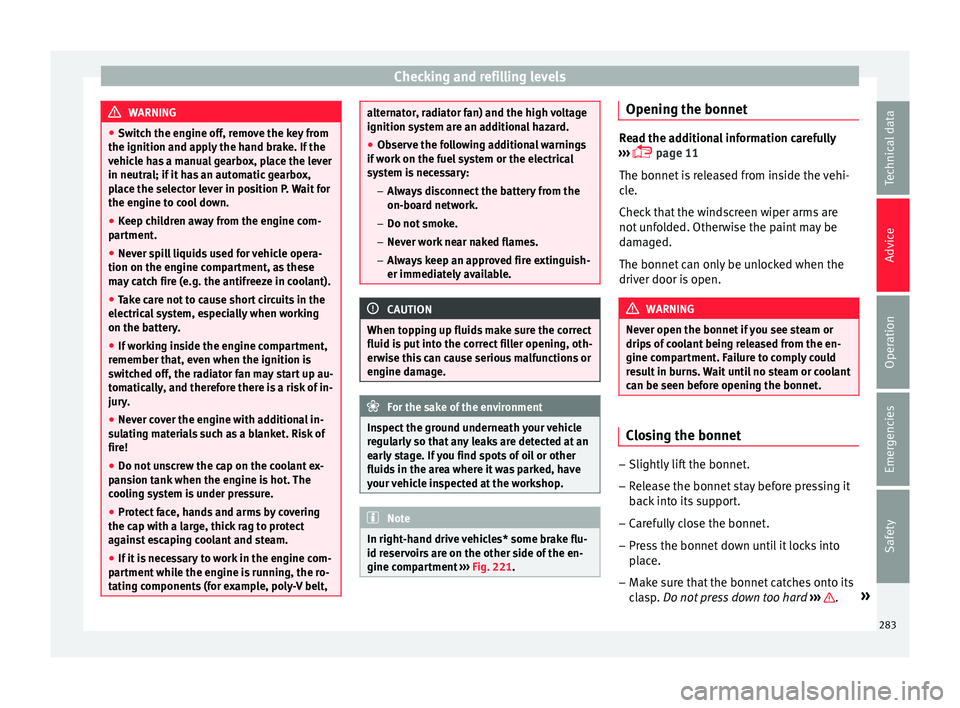
Checking and refilling levels
WARNING
● Sw it
ch the engine off, remove the key from
the ignition and apply the hand brake. If the
vehicle has a manual gearbox, place the lever
in neutral; if it has an automatic gearbox,
place the selector lever in position P. Wait for
the engine to cool down.
● Keep children away from the engine com-
par
tment.
● Never spill liquids used for vehicle opera-
tion on the engine c
ompartment, as these
may catch fire (e.g. the antifreeze in coolant).
● Take care not to cause short circuits in the
electric
al system, especially when working
on the battery.
● If working inside the engine compartment,
remember th
at, even when the ignition is
switched off, the radiator fan may start up au-
tomatically, and therefore there is a risk of in-
jury.
● Never cover the engine with additional in-
su
lating materials such as a blanket. Risk of
fire!
● Do not unscrew the cap on the coolant ex-
pan
sion tank when the engine is hot. The
cooling system is under pressure.
● Protect face, hands and arms by covering
the cap w
ith a large, thick rag to protect
against escaping coolant and steam.
● If it is necessary to work in the engine com-
par
tment while the engine is running, the ro-
tating components (for example, poly-V belt, alternator, radiator fan) and the high voltage
ignition sy
s
tem are an additional hazard.
● Observe the following additional warnings
if w
ork on the fuel system or the electrical
system is necessary:
– Always disconnect the battery from the
on-board network.
– Do not smoke.
– Never work near naked flames.
– Always keep an approved fire extinguish-
er immediately available. CAUTION
When topping up fluids make sure the correct
fluid i s
put into the correct filler opening, oth-
erwise this can cause serious malfunctions or
engine damage. For the sake of the environment
Inspect the ground underneath your vehicle
r e
gularly so that any leaks are detected at an
early stage. If you find spots of oil or other
fluids in the area where it was parked, have
your vehicle inspected at the workshop. Note
In right-hand drive vehicles* some brake flu-
id r e
servoirs are on the other side of the en-
gine compartment ››› Fig. 221. Opening the bonnet
Read the additional information carefully
› ›
› page 11
The bonnet is released from inside the vehi-
cle.
Check that the windscreen wiper arms are
not unfolded. Otherwise the paint may be
damaged.
The bonnet can only be unlocked when the
driver door is open. WARNING
Never open the bonnet if you see steam or
drip s
of coolant being released from the en-
gine compartment. Failure to comply could
result in burns. Wait until no steam or coolant
can be seen before opening the bonnet. Closing the bonnet
–
Slightly lift the bonnet.
– Release the bonnet stay before pressing it
bac
k into its support.
– Carefully close the bonnet.
– Press the bonnet down until it locks into
pl
ace.
– Make sure that the bonnet catches onto its
cl
asp. Do not press down too hard ››› .
»
283
Technical data
Advice
Operation
Emergencies
Safety
Page 287 of 328
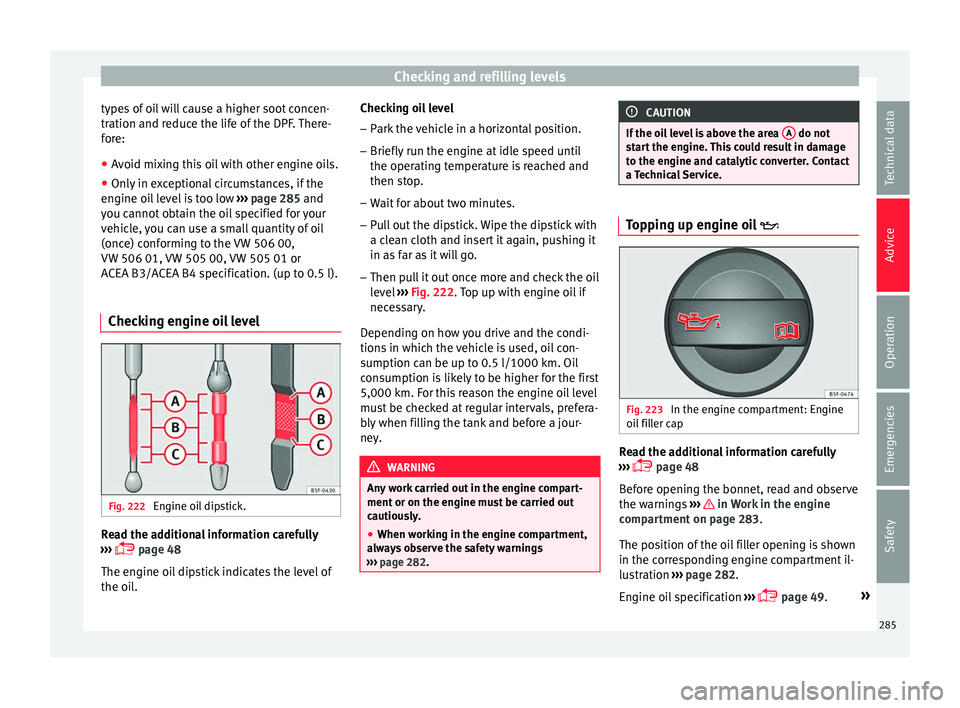
Checking and refilling levels
types of oil will cause a higher soot concen-
tr ation and r
educe the life of the DPF. There-
fore:
● Avoid mixing this oil with other engine oils.
● Only in exceptional circumstances, if the
engine oi
l level is too low ››› page 285 and
you cannot obtain the oil specified for your
vehicle, you can use a small quantity of oil
(once) conforming to the VW 506 00,
VW 506 01, VW 505 00, VW 505 01 or
ACEA B3/ACEA B4 specification. (up to 0.5 l).
Checking engine oil level Fig. 222
Engine oil dipstick. Read the additional information carefully
› ›
› page 48
The engine oil dipstick indicates the level of
the oil. Checking oil level
– Park the vehicle in a horizontal position.
– Briefly run the engine at idle speed until
the operatin
g temperature is reached and
then stop.
– Wait for about two minutes.
– Pull out the dipstick. Wipe the dipstick with
a cl
ean cloth and insert it again, pushing it
in as far as it will go.
– Then pull it out once more and check the oil
lev
el ››› Fig. 222. Top up with engine oil if
necessary.
Depending on how you drive and the condi-
tions in which the vehicle is used, oil con-
sumption can be up to 0.5 l/1000 km. Oil
consumption is likely to be higher for the first
5,000 km. For this reason the engine oil level
must be checked at regular intervals, prefera-
bly when filling the tank and before a jour-
ney. WARNING
Any work carried out in the engine compart-
ment or on the en
gine must be carried out
cautiously.
● When working in the engine compartment,
alw
ays observe the safety warnings
››› page 282. CAUTION
If the oil level is above the area A do not
s t
art the engine. This could result in damage
to the engine and catalytic converter. Contact
a Technical Service. Topping up engine oil
Fig. 223
In the engine compartment: Engine
oi l
filler cap Read the additional information carefully
› ›
› page 48
Before opening the bonnet, read and observe
the warnings ››› in Work in the engine
c omp
artment on page 283.
The position of the oil filler opening is shown
in the corresponding engine compartment il-
lustration ››› page 282.
Engine oil specification ›››
page 49. »
285
Technical data
Advice
Operation
Emergencies
Safety
Page 288 of 328

Advice
WARNING
Oil is highly inflammable! Ensure that no oil
c ome
s into contact with hot engine compo-
nents when topping up. CAUTION
If the oil level is above the area A do not
s t
art the engine. This could result in damage
to the engine and catalytic converter. Contact
a specialised workshop. For the sake of the environment
The oil level must never be above area A .
Other w
ise oil can be drawn in through the
crankcase breather and escape into the at-
mosphere via the exhaust system. Note
Before a long trip, we recommend finding an
en gine oi
l that conforms to the correspond-
ing VW specifications and recommend keep-
ing it in the vehicle. This way, the correct en-
gine oil will always be available for a top-up if
needed. Changing engine oil
Read the additional information carefully
› ›
› page 48.
The engine oil must be changed at the inter-
vals given in the service schedule. We recommend that you have the engine oil
ch
anged by a Technical Service.
The oil change intervals are shown in the
Maintenance Programme. WARNING
Only change the engine oil yourself if you
h av
e the specialist knowledge required!
● Before opening the bonnet, read and ob-
serv
e the warnings ››› page 282.
● Wait for the engine to cool down. Hot oil
ma
y cause burn injuries.
● Wear eye protection to avoid injuries, such
as
acid burns, caused by splashes of oil.
● When removing the oil drain plug with your
fing
ers, keep your arm horizontal to help pre-
vent oil from running down your arm.
● Wash your skin thoroughly if it comes into
cont
act with engine oil.
● Engine oil is poisonous! Used oil must be
st
ored in a safe place out of the reach of chil-
dren. CAUTION
No additives should be used with engine oil.
Thi s
could result in engine damage. Any dam-
age caused by the use of such additives
would not be covered by the factory warranty. For the sake of the environment
● Bec
ause of disposal problems and the spe-
cial tools and specialist knowledge required,
we recommend that you have the engine oil
and filter changed by a Technical Service.
● Never pour oil down drains or into the
grou
nd.
● Use a suitable container when draining the
used oi
l. It must be large enough to hold all
the engine oil. Cooling system
Top
ping up coolant Read the additional information carefully
› ›
› page 49
Top up coolant when the level is below the
MIN (minimum) mark.
Checking coolant level
– Park the vehicle in a horizontal position.
– Switch the ignition off.
– Read off the coolant level on coolant ex-
pan
sion tank. When the engine is cold, the
coolant level should be between the marks.
When the engine is hot, it may be slightly
above the upper mark.
286
Page 289 of 328

Checking and refilling levels
Topping up coolant
– Wait for the engine to cool down.
– Cover the coolant expansion tank cap with
a c loth and c
arefully unscrew it to the left
››› .
– Top up the coolant only if there is still cool-
ant in the e
xpansion tank, otherwise you
could damage the engine. If there is no
coolant in the expansion tank, do not con-
tinue driving. You should obtain professio- nal assistance ››› .
– If there is still some coolant in the expan-
sion t
ank, top up to the upper mark.
– Top up with coolant until the level becomes
st
able.
– Screw the cap back on correctly.
Any
loss of coolant fluid normally indicates a
leak in the cooling system. Take the vehicle
straight to a specialised workshop to have
the cooling system examined. If there are no
leaks in the engine cooling system, a loss of
coolant can only occur if the coolant boils
and is forced out of the system as a result of
overheating. WARNING
● The c oo
ling system is under pressure. Do
not unscrew the cap on the coolant expan-
sion tank when the engine is hot: risk of
burns! ●
The antifr eez
e and coolant fluid can be a
health hazard. Therefore, the antifreeze
should be stored in the original container in a
safe place out of reach of children. Failure to
comply could result in poisoning.
● If working inside the engine compartment,
remember th
at, even when the ignition is
switched off, the radiator fan may start up au-
tomatically, and therefore there is a risk of in-
jury. WARNING
If there is not enough anti-freeze in the cool-
ant sy
stem, the engine may fail leading to se-
rious damage.
● Please make sure that the percentage of
ad
ditive is correct with respect to the lowest
expected ambient temperature in the zone in
which the vehicle is to be used.
● When the outside temperature is very low,
the coo
lant could freeze and the vehicle
would be immobilised. In this case, the heat-
ing would not work either and inadequately
dressed passengers could die of cold. CAUTION
Do not top up the expansion tank with cool-
ant fluid if
it is empty! Air could enter the
cooling system. In this case, stop driving.
Seek specialist assistance. Otherwise, there
is a risk of engine damage. CAUTION
The original additives should never be mixed
w ith c
oolants which are not approved by
SEAT. Otherwise, you run the risk of causing
severe damage to the engine and the engine
cooling system.
● If the fluid in the expansion tank is not pur-
pl
e but is, for example, brown, this indicates
that the G13 additive has been mixed with an
inadequate coolant. The coolant must be
changed as soon as possible if this is the
case! This could result in serious faults and
engine damage. For the sake of the environment
Coolants and additives can contaminate the
en v
ironment. If any fluids are spilled, they
should be collected and correctly disposed
of, with respect to the environment. Brake fluid
Top
ping up brake fluid Read the additional information carefully
› ›
› page 50
Checking the brake fluid level
The brake fluid level must be between the
MIN and MAX markings. »
287
Technical data
Advice
Operation
Emergencies
Safety
Page 291 of 328
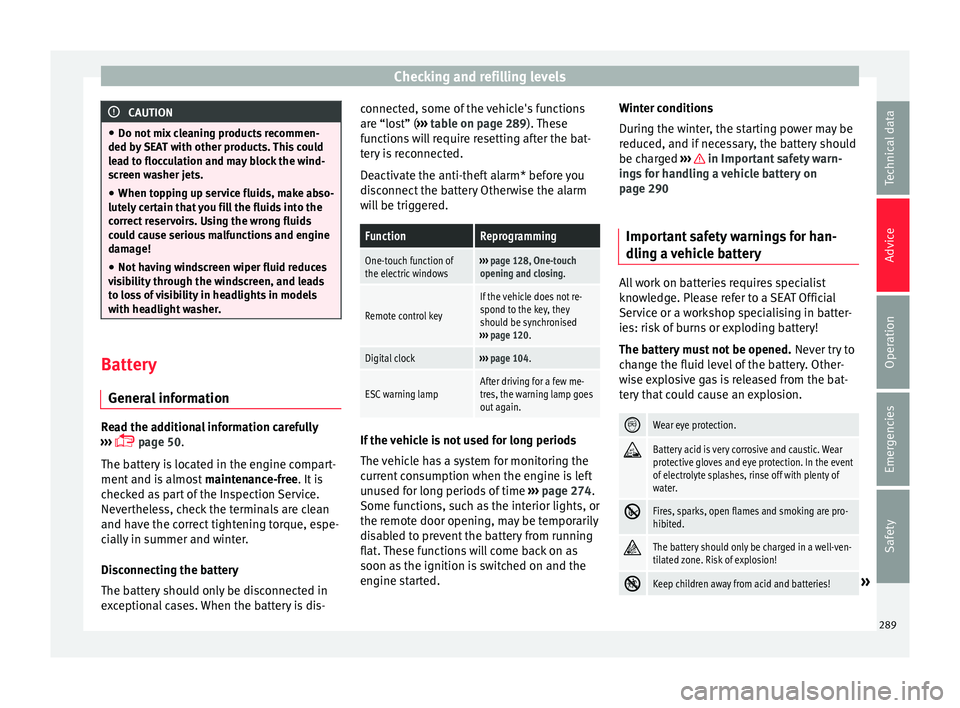
Checking and refilling levels
CAUTION
● Do not mi
x cleaning products recommen-
ded by SEAT with other products. This could
lead to flocculation and may block the wind-
screen washer jets.
● When topping up service fluids, make abso-
lutely
certain that you fill the fluids into the
correct reservoirs. Using the wrong fluids
could cause serious malfunctions and engine
damage!
● Not having windscreen wiper fluid reduces
vi
sibility through the windscreen, and leads
to loss of visibility in headlights in models
with headlight washer. Battery
Gener a
l information Read the additional information carefully
› ›
› page 50.
The battery is located in the engine compart-
ment and is almost maintenance-free. It is
checked as part of the Inspection Service.
Nevertheless, check the terminals are clean
and have the correct tightening torque, espe-
cially in summer and winter.
Disconnecting the battery
The battery should only be disconnected in
exceptional cases. When the battery is dis- connected, some of the vehicle's functions
are “lo
st” (››› table on page 289). These
functions will require resetting after the bat-
tery is reconnected.
Deactivate the anti-theft alarm* before you
disconnect the battery Otherwise the alarm
will be triggered.
FunctionReprogramming
One-touch function of
the electric windows››› page 128, One-touch
opening and closing.
Remote control key
If the vehicle does not re-
spond to the key, they
should be synchronised
››› page 120.
Digital clock››› page 104.
ESC warning lampAfter driving for a few me-
tres, the warning lamp goes
out again. If the vehicle is not used for long periods
The
v
ehicle has a system for monitoring the
current consumption when the engine is left
unused for long periods of time ››› page 274.
Some functions, such as the interior lights, or
the remote door opening, may be temporarily
disabled to prevent the battery from running
flat. These functions will come back on as
soon as the ignition is switched on and the
engine started. Winter conditions
Durin
g the winter, the starting power may be
reduced, and if necessary, the battery should
be charged ››› in Important safety warn-
in g
s for handling a vehicle battery on
page 290
Important safety warnings for han-
dling a
vehicle battery All work on batteries requires specialist
kno
wl
edge. Please refer to a SEAT Official
Service or a workshop specialising in batter-
ies: risk of burns or exploding battery!
The battery must not be opened. Never try to
change the fluid level of the battery. Other-
wise explosive gas is released from the bat-
tery that could cause an explosion.
Wear eye protection.
Battery acid is very corrosive and caustic. Wear
protective gloves and eye protection. In the event
of electrolyte splashes, rinse off with plenty of
water.
Fires, sparks, open flames and smoking are pro-
hibited.
The battery should only be charged in a well-ven-
tilated zone. Risk of explosion!
Keep children away from acid and batteries!»
289
Technical data
Advice
Operation
Emergencies
Safety
Page 293 of 328
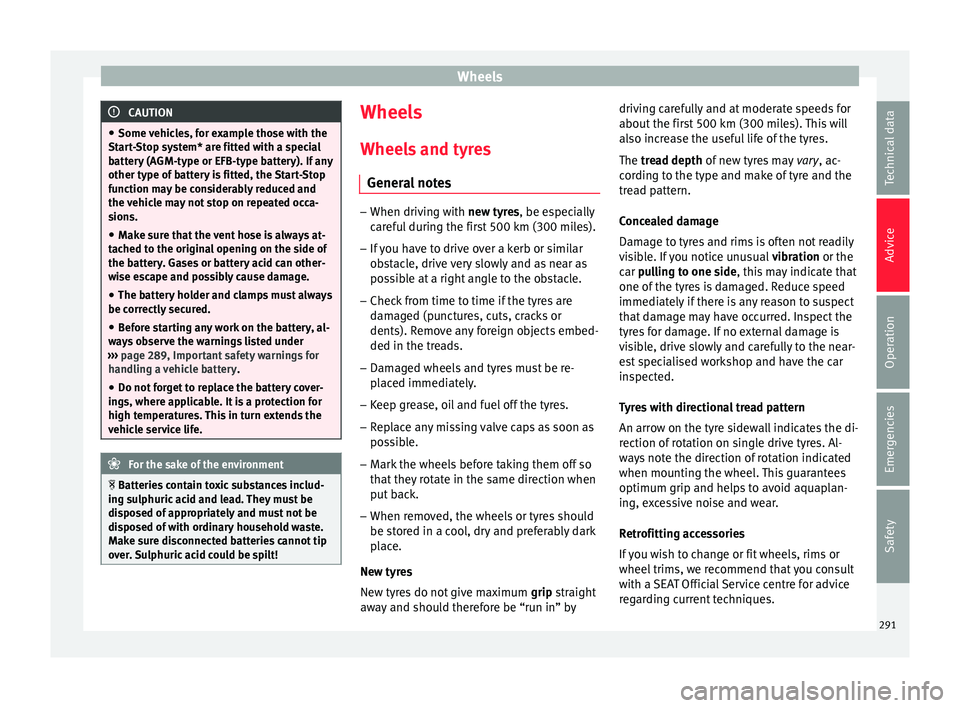
Wheels
CAUTION
● Some v
ehicles, for example those with the
Start-Stop system* are fitted with a special
battery (AGM-type or EFB-type battery). If any
other type of battery is fitted, the Start-Stop
function may be considerably reduced and
the vehicle may not stop on repeated occa-
sions.
● Make sure that the vent hose is always at-
tac
hed to the original opening on the side of
the battery. Gases or battery acid can other-
wise escape and possibly cause damage.
● The battery holder and clamps must always
be corr
ectly secured.
● Before starting any work on the battery, al-
wa
ys observe the warnings listed under
››› page 289, Important safety warnings for
handling a vehicle battery .
● Do not forget to replace the battery cover-
ing
s, where applicable. It is a protection for
high temperatures. This in turn extends the
vehicle service life. For the sake of the environment
B atteries contain toxic substances includ-
in
g sulphuric acid and lead. They must be
disposed of appropriately and must not be
disposed of with ordinary household waste.
Make sure disconnected batteries cannot tip
over. Sulphuric acid could be spilt! Wheels
Wheel s
and tyres
General notes –
When driving with new ty r
es, be especially
careful during the first 500 km (300 miles).
– If you have to drive over a kerb or similar
ob
stacle, drive very slowly and as near as
possible at a right angle to the obstacle.
– Check from time to time if the tyres are
dam
aged (punctures, cuts, cracks or
dents). Remove any foreign objects embed-
ded in the treads.
– Damaged wheels and tyres must be re-
pl
aced immediately.
– Keep grease, oil and fuel off the tyres.
– Replace any missing valve caps as soon as
pos
sible.
– Mark the wheels before taking them off so
that
they rotate in the same direction when
put back.
– When removed, the wheels or tyres should
be st
ored in a cool, dry and preferably dark
place.
New tyres
New tyres do not give maximum grip straight
away and should therefore be “run in” by driving carefully and at moderate speeds for
about the fir
st 500 km (300 miles). This will
also increase the useful life of the tyres.
The tread depth of new tyres may vary, ac-
cording to the type and make of tyre and the
tread pattern.
Concealed damage
Damage to tyres and rims is often not readily
visible. If you notice unusual vibration or the
car pulling to one side, this may indicate that
one of the tyres is damaged. Reduce speed
immediately if there is any reason to suspect
that damage may have occurred. Inspect the
tyres for damage. If no external damage is
visible, drive slowly and carefully to the near-
est specialised workshop and have the car
inspected.
Tyres with directional tread pattern
An arrow on the tyre sidewall indicates the di-
rection of rotation on single drive tyres. Al-
ways note the direction of rotation indicated
when mounting the wheel. This guarantees
optimum grip and helps to avoid aquaplan-
ing, excessive noise and wear.
Retrofitting accessories
If you wish to change or fit wheels, rims or
wheel trims, we recommend that you consult
with a SEAT Official Service centre for advice
regarding current techniques.
291
Technical data
Advice
Operation
Emergencies
Safety
Page 294 of 328
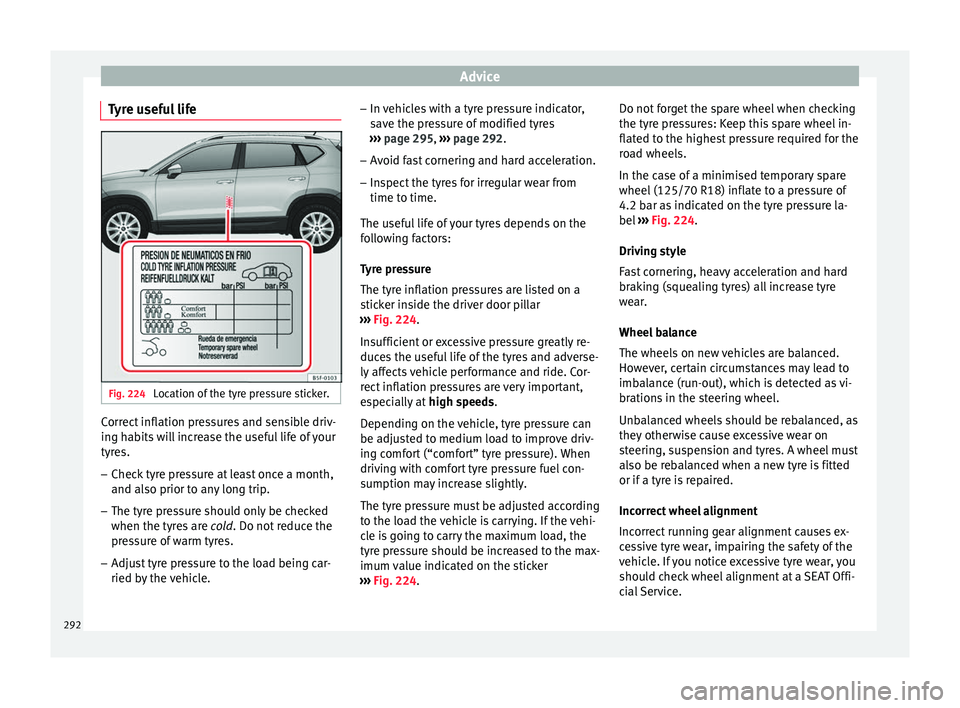
Advice
Tyre useful life Fig. 224
Location of the tyre pressure sticker. Correct inflation pressures and sensible driv-
in
g h
abits will increase the useful life of your
tyres.
– Check tyre pressure at least once a month,
and also prior t
o any long trip.
– The tyre pressure should only be checked
when the tyr
es are cold. Do not reduce the
pressure of warm tyres.
– Adjust tyre pressure to the load being car-
ried by
the vehicle. –
In v
ehicles with a tyre pressure indicator,
save the pressure of modified tyres
››› page 295, ››› page 292.
– Avoid fast cornering and hard acceleration.
– Inspect the tyres for irregular wear from
time to time.
The u
seful life of your tyres depends on the
following factors:
Tyre pressure
The tyre inflation pressures are listed on a
sticker inside the driver door pillar
››› Fig. 224.
Insufficient or excessive pressure greatly re-
duces the useful life of the tyres and adverse-
ly affects vehicle performance and ride. Cor-
rect inflation pressures are very important,
especially at high speeds.
Depending on the vehicle, tyre pressure can
be adjusted to medium load to improve driv-
ing comfort (“comfort” tyre pressure). When
driving with comfort tyre pressure fuel con-
sumption may increase slightly.
The tyre pressure must be adjusted according
to the load the vehicle is carrying. If the vehi-
cle is going to carry the maximum load, the
tyre pressure should be increased to the max-
imum value indicated on the sticker
››› Fig. 224. Do not forget the spare wheel when checking
the tyr
e pressures: Keep this spare wheel in-
flated to the highest pressure required for the
road wheels.
In the case of a minimised temporary spare
wheel (125/70 R18) inflate to a pressure of
4.2 bar as indicated on the tyre pressure la-
bel ››› Fig. 224.
Driving style
Fast cornering, heavy acceleration and hard
braking (squealing tyres) all increase tyre
wear.
Wheel balance
The wheels on new vehicles are balanced.
However, certain circumstances may lead to
imbalance (run-out), which is detected as vi-
brations in the steering wheel.
Unbalanced wheels should be rebalanced, as
they otherwise cause excessive wear on
steering, suspension and tyres. A wheel must
also be rebalanced when a new tyre is fitted
or if a tyre is repaired.
Incorrect wheel alignment
Incorrect running gear alignment causes ex-
cessive tyre wear, impairing the safety of the
vehicle. If you notice excessive tyre wear, you
should check wheel alignment at a SEAT Offi-
cial Service.
292
Page 295 of 328
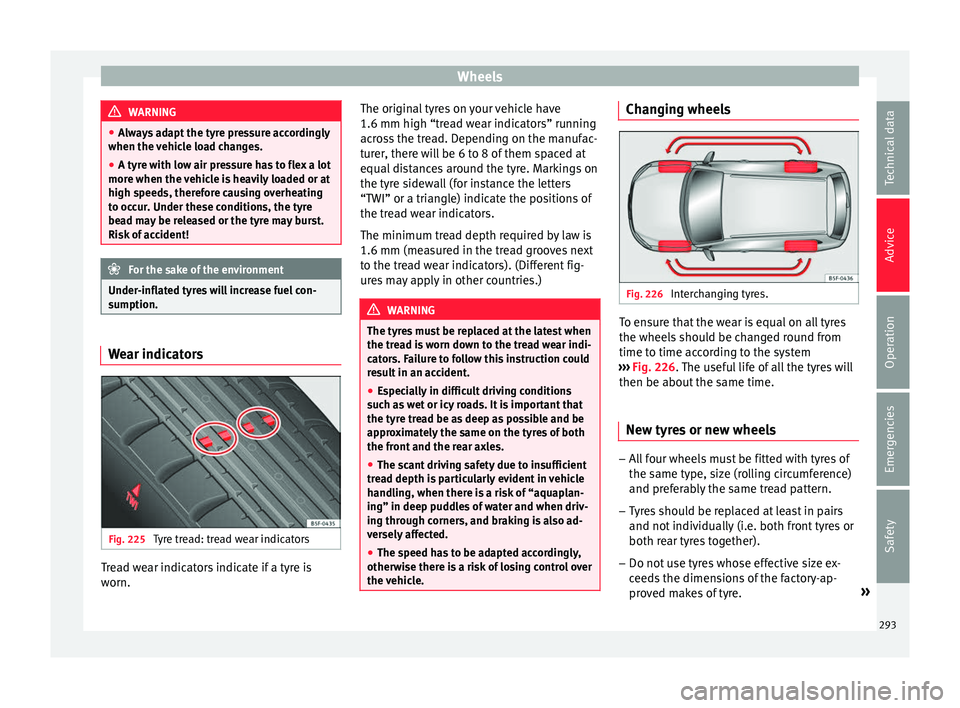
Wheels
WARNING
● Alw
ays adapt the tyre pressure accordingly
when the vehicle load changes.
● A tyre with low air pressure has to flex a lot
more when the
vehicle is heavily loaded or at
high speeds, therefore causing overheating
to occur. Under these conditions, the tyre
bead may be released or the tyre may burst.
Risk of accident! For the sake of the environment
Under-inflated tyres will increase fuel con-
s umption. Wear indicators
Fig. 225
Tyre tread: tread wear indicators Tread wear indicators indicate if a tyre is
w
orn. The origin
al tyres on your vehicle have
1.6 mm high “tre
ad wear indicators” running
across the tread. Depending on the manufac-
turer, there will be 6 to 8 of them spaced at
equal distances around the tyre. Markings on
the tyre sidewall (for instance the letters
“TWI” or a triangle) indicate the positions of
the tread wear indicators.
The minimum tread depth required by law is
1.6 mm (measured in the tread grooves next
to the tread wear indicators). (Different fig-
ures may apply in other countries.) WARNING
The tyres must be replaced at the latest when
the tr e
ad is worn down to the tread wear indi-
cators. Failure to follow this instruction could
result in an accident.
● Especially in difficult driving conditions
suc
h as wet or icy roads. It is important that
the tyre tread be as deep as possible and be
approximately the same on the tyres of both
the front and the rear axles.
● The scant driving safety due to insufficient
tre
ad depth is particularly evident in vehicle
handling, when there is a risk of “aquaplan-
ing” in deep puddles of water and when driv-
ing through corners, and braking is also ad-
versely affected.
● The speed has to be adapted accordingly,
otherw
ise there is a risk of losing control over
the vehicle. Changing wheels
Fig. 226
Interchanging tyres. To ensure that the wear is equal on all tyres
the wheel
s
should be changed round from
time to time according to the system
››› Fig. 226. The useful life of all the tyres will
then be about the same time.
New tyres or new wheels –
All four wheels must be fitted with tyres of
the s ame type, s
ize (rolling circumference)
and preferably the same tread pattern.
– Tyres should be replaced at least in pairs
and not indiv
idually (i.e. both front tyres or
both rear tyres together).
– Do not use tyres whose effective size ex-
ceed
s the dimensions of the factory-ap-
proved makes of tyre. »
293
Technical data
Advice
Operation
Emergencies
Safety